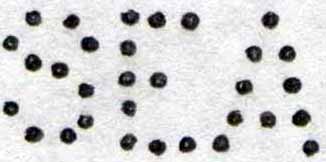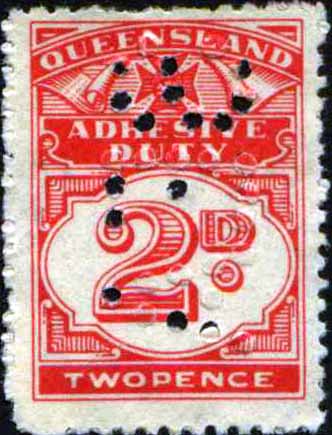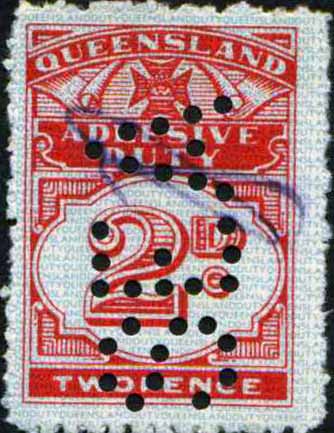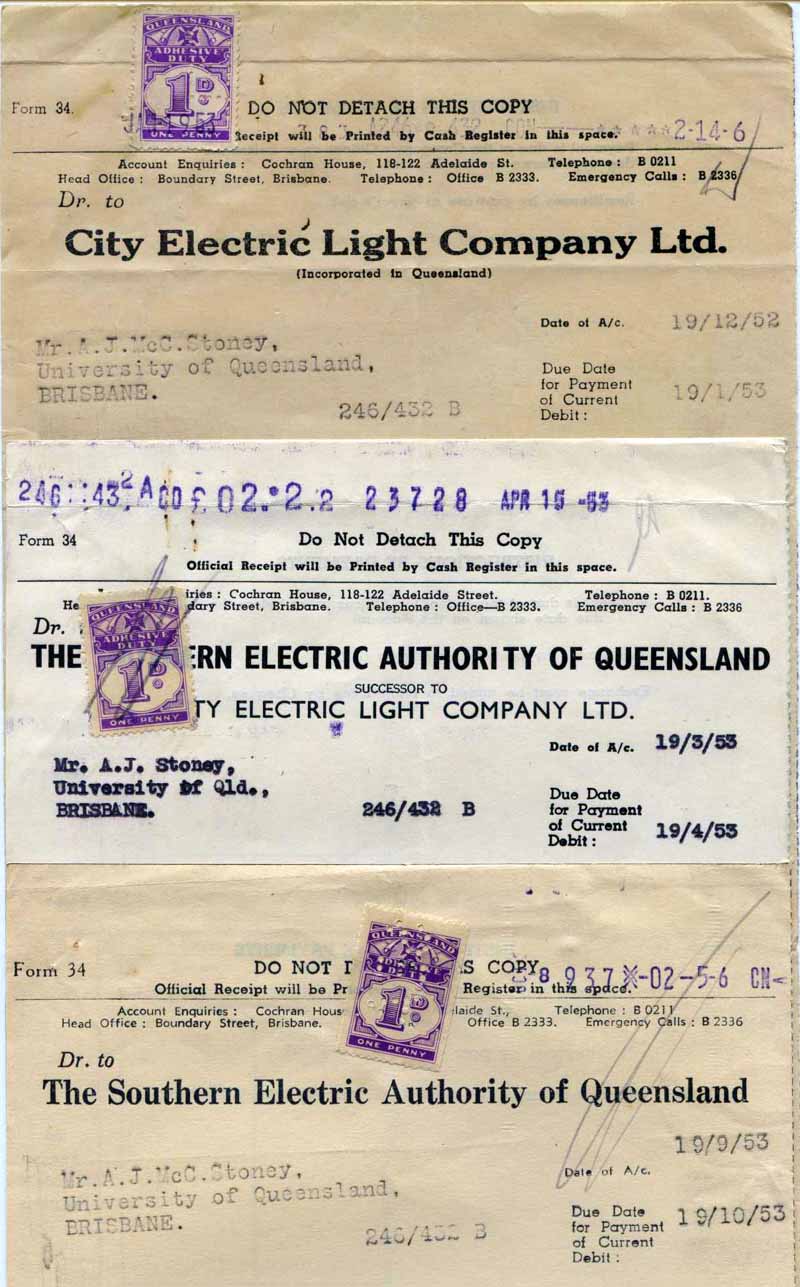|
Private Revenue Perfins of Queensland An Elsmore Coath production The authors would welcome your comments additions or input into this work
A B C E F G H I K L M N O P Q R S T V W Other S -------------------------------------------------------- SEA.a User: The Southern Electric Authority of Qld. Electricity Distribution Address: 156 Boundary St, Brisbane, QLD Revenue usage: Numeral 1936 issue 1d, 2d, 3d, 6d, 1/-. 1956 Security underprint 2d. 1966 issue 2c. Rarity Scale: Numeral 1936 issue 1d R4, 2d R1, 3d R2, 6d R4, 1/- R3. 2d underprint R4. 1966 issue 2c R2. Background: In 1939 the State
Electric Company was formed to manage the transfer
of the responsibility for the provision and
distribution of electricity in Queensland from the
public company, City Electric Light Company (see
CEL), to a Government body. This process was somewhat delayed
by World War 2 but in 1952 the Southern Electric
Authority (SEA) of Queensland Act was passed which
saw the shareholders of the City Electric Company
bought out by public funds. The management and
existing board stayed in place but with the addition
of the State Electricity Commissioner and the
undersecretary to Treasury. The SEA was
officially launched on 1 February 1953 as a public
authority which was intended to run until June 1968
when the authority would be absorbed into the
Queensland Government without further payment. Device: The SEA device was most
likely a single head device and due to the narrow
nature of the revenue stamps of the period it is
generally struck to read vertically up the stamp
(position 2) and occasionally reversed (position 6).
The pattern is only found on
revenue stamps of Queensland from 1953 until 1967. Related patterns: Refer to other
Queensland Electrical Authority patterns in: QLD: CEL.a Other – Section 2 Commercial Overprints Regional.a SEA.a WBBR/EB.a Notes: The City Electric Light Company Limited was taken over in 1953 by The Southern Electric Authority of Queensland. See CEL.a Below shows a run of documents being the last known date [top document] for CEL.a [19/12/1952] and the first two electric bills [middle document] from SEA take over without a perfin devise ready for use, this finally came on the third issue bill 19/9/1953 [bottom document] Note: SEA finally chose to precancel their revenues with an SEA overprint. See Other Tab. -------------------------------------------------------- S&H.a User: Stewart & Hemmant. Draperies, Clothiers, Manufacturers and Warehouseman Address: 174 Queen St, Brisbane, QLD Revenue Use: QV (1892) 6d, 1/-. (widow weeds) 1d. KEDVII 1901 issue 1d, 2d, 3d, 3d (double) R4, 6d, 1/- 6mm Q wmk, 1/-, 8mm Q wmk KGV 1920 issue 1d, 2d. Rarity Scale: QV (1892) 6d R4, 1/- R4. 1d (widow weeds) R4. KEDVII 1901 issue 1d R1, 2d R1, 3d R1, 3d (double) R4, 6d R4, 1/- (6mm Q wmk) R4, 1/-, (8mm Q wmk) R2. KGV 1920 issue 1d R4, 2d R4. Railway Use: 1902 issue 3d, 6d. Rarity Scale: 1902 issue 3d R3, 6d R3. Background: Alexander Stewart and
William Hemmant started Stewart and Hemmant as a
partnership in Brisbane in around 1863. Initially as
a Drapery on the corner of Queen and Albert Streets
but after a fire which engulfed an entire city
block, including their premises, they relocated to
the corner of Queen and Adelaide Streets where they
expanded into retail clothing. The partnership was dissolved in
1871 when Hemmant entered Parliament. However
Hemmant remained with the firm in Brisbane and later
in the London office in diminishing roles until his
death in 1916. The company grew through the 1880’s
and started to manufacture clothing in work rooms in
Adelaide Street to supplement the range of imported
clothing that they sourced. Later in 1898 they took
the bold step of establishing a purpose built
manufacturing plant in Fortitude Valley. This
was a large premise and on commencement they
employed over 275 machine operators. They later
built another manufacturing plant at Ipswich. In 1903 the Company was
restructured as Alexander Stewart and Sons and all
shares were allocated to the family. Despite
the name change the company continued to use the
S&H device. In 1921 preference shares were made
available to the general public. In September 1926
the company went into voluntary liquidation. Device: The device is a single head
device and it was most likely located in the Queen
Street premises as there is no postmark or cachet
evidence of Fortitude Valley of Ipswich use. There
are subtle changes to the pattern over time. In
around 1906 the shape of the H alters slightly and
the left hand upright develops a slight bend the
right near the top. Later around 1915 the right hand
upright of the H shows a distinct wobble above the
cross bar of the H. Both of these changes are most
likely the results of repairs to the device. These
repairs may have ceased after 1915 as towards the
end of the devices life it is characterised by
missing pins in the S and the top of the H and the
strikes tend to have many incomplete holes. The pattern is found on postage
stamps of Queensland and the early Commonwealth
period as well as Queensland revenues and railways.
Usage is from 1899 until about 1920. Related patterns: Nil -------------------------------------------------------- SH/&Co.a User: S.(Sigmund) Hoffnung & Co Ltd. Importers & Merchants Address: 203 Charlotte St, Brisbane, QLD Revenue Use: QV (1882 state issue) 1d. QV (1895 state issue) 1d. QV (widow weeds) 1d. KEDVII 1d, 2d, 3d, 3d (double), 6d, 1/-. KGV 1920 issue 1d, 2d, 3d, 1/-. Numeral 2d, 3d, 6d. Rarity Scale: QV (1882 state issue) 1d R3. QV (widow weeds) 1d. QV (1895 state issue) 1d R2. KEDVII 1d R4, 2d R3, 3d R4, 3d (double) R4, 6d R4, 1/- R4. KGV 1920 issue 1d R3, 2d R2, 3d R4, 1/- R4. Numeral 2d R4, 3d R4, 6d R4. Railway Use: 1902 issue 1d, 3d, 6d, 1/-. 1915 issue 2/6d. 1919 issue 3d. 1921 rouletted issue 3d. 1927 numeral issue 5d, 6d, 1/-. Rarity Scale: 1902 issue 1d R3, 3d R3, 6d R3, 1/- R4. 1915 issue 3d R4, 2/6d R4. 1919 issue 3d R4. 1921 rouletted issue 3d R4. 1927 numeral issue 5d R3, 6d R3, 1/- R3. Background: Sigmond Hoffnung was
born in Poland in 1830, the son of a Jewish Rabbi,
but his family migrated to England in 1936. He was
educated in Liverpool but due to lack of money he
took a job as a junior salesman with a West Country
firm. This proved beneficial as he became friendly
with a customer, Henry Nathan, who lent him £500 to
buy assorted goods and take them to Sydney for
resale. Hoffnung arrived in Sydney early in
1852 and opened a wholesale business in Wynyard
Square. Sales went well and he was able to repay his
loan and subsequently secured more stock from
England with Nathan acting as his buyer. This
arrangement proved successful and in 1855 Hoffnung
moved to larger premises in George Street. He
returned to England briefly in 1857 to formalise his
partnership with Nathan and to make purchases of
more stock. In 1870 S. Hoffnung & Co. moved
into new premises in Pitt Street and in 1871 they
opened a Brisbane branch. The company also
established other branches in Australia, New Zealand
and Fiji and had its head office in London. They
also had a large factory in Sydney making saddlery
and harnesses. Their range of wholesale goods
included American canned fruits and jams, watches,
glass and china, ironmongery, rocking-horses,
firearms, iron safes and patent medicines. Hoffnung
set up the first opal-cutting business in Australia
and exported uncut diamonds and sapphires for
industrial use. In 1875 he was on the committee of
the Trade Protection Society of New South Wales. In 1877 Hoffnung returned to
England and took charge of the London office. His
brother Abraham, who had been a successful merchant
in America, Canada and England, joined S. Hoffnung
& Co. in 1886. Abraham spent some years in both
Australia and in London. In 1889 Sigmund retired
from the company and it was restructured as a public
company in 1902. Later the company moved its
headquarters to 153 Clarence Street, Sydney. Hoffnung died on 27 August 1904
aged 74. He was survived by his wife and their only
child Sidney. Sidney worked in the company and after
marrying Violet Goldsmid, he took the name
Hoffnung-Goldsmid. He served as a director of the
company and died in 1930. Device: S Hoffnung and Co used a
range of devices in their offices in Sydney
including various formats of SH and SH/&/COLTD
but in the main they used SH/&CO. This Brisbane
SH/&CO is the only pattern found used in
Queensland. S Hoffnung and Co first applied to
the NSW postal authorities in 1887 for approval to
use perfins but no record has been found of the
application for this Brisbane device with the
Queensland Post Office. The Brisbane SH/&CO device was a long serving one being used from c1891 to as recently as 1975. It was a single head device and is found in a variety of positions. The device shows signs of deterioration from about the mid 1930’s that does not seem to have been addressed. Strikes of the pattern become progressively weaker and by the 1960’s the pattern often contains many blind pins. Related patterns: Refer to other S
Hoffnung and Co patterns in: NSW: SH/&CO.a SH/&CO.b SH/&CO.c S.H./&/COLTD..a -------------------------------------------------------- SU.a Used as a cancelling devise User: The Southern Union General Insurance Coy of Australia Ltd. Insurance Provider Address: 119 Eagle St, Brisbane, QLD Revenue Use: KGV 1926 issue 2d, 10/-. Rarity Scale: KGV 1926 issue 2d R4, 10/- R4. Background: Very little is known about the history of the Southern Union Insurance Company. This is surprising as evidence from policy documents indicates that they were trading from as early as 1926 until at least the early 1930's. What is more the company appears on the “Roll of Underwriters” in the 1934 Victorian Government Gazette. Their policy documents list offices in all Australian capital cities as well as Geelong and Launceston and Auckland, Christchurch, Dunedin and Wellington in New Zealand. Given this wide distribution of offices, even if they are only brokers acting for the Company, it is surprising that more is not known about them. Device: This pattern is very rare and therefore there are few examples to study. The device was most likely a single head device and the shape of the letters in the pattern is rather crude. This suggests that it may have been of local manufacture in Brisbane as it is not found on stamps of other States or New Zealand. Strikes of the pattern are generally poor and the holes are not clear. The lone example on a document indicates that it was used as a cancelling device in that instance, but it may have been used as a pre cancelling device as well. The pattern is only found on revenue stamps and the example on document indicates use in 1926. Given the poor performance of the device and its rarity it is likely that its use was short lived. This short lived usage of the device is supported by the fact that from 1930 Southern Union began embossing stamps on its policies so as to give an even greater level of security. Related Patterns: Nil Note: The scarcity of this perfin came about after Southern Union c1930 turned to embossing stamps on it's policies which provided a greater security. --------------------------------------------------------
A B C E F G H I K L M N O P Q R S T V W Other © copyright 2011 |















